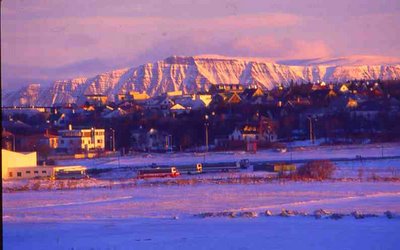
The U.S. Department of Energy predicts a 25.7% increase in home heating bills this winter. For my family, it’ll be ugly. Our front-gabled New Englander is a beauty, and we love her, but she’s three floors of uninsulated, 110-year-old walls with their attendant 110-year-old chinks, cracks and crevices. Baby, it’s cold inside.
In a normal year, which this isn’t, we see a gas bill or two that hovers around a grand. I gasp when I look at them. This year, I’ll probably go apoplectic before I even open January’s and February’s envelopes. I’ll feel the killer largeness of the numbers right through the paper. I’m already having thirteen-hundred-dollar nightmares. I’m sitting at a desk wrapped in Bob Cratchit stockings and scarves, writing a check by the flicker of light from a candle stub. An evil Scrooge voice laughs, “Yes! Thirteen-hundred dollars for hot air! For something you can’t even see!” I shiver and pass the check to the mean man.
Makes me want to move to Iceland, where it’s warm. There, heat, lots of it, is pumped from the earth. And it’s cheap.
I saw Iceland’s steaming, geothermal bounty before setting foot in the country. On our approach to Keflavik Airport, some 50 minutes from Reykjavik (above), I looked down on the powerful sight of jet black volcanic cliffs rising from the sea and topped in shimmering white ice and snow. Iceland looked like a gargantuan devil’s food cake sitting under layers of vanilla frosting.
Then, just beyond the airport, I saw steam. Massive billows of white-hot steam, gigantic and foamy and eerie, rising from a pool of aquamarine water. Round clouds puffing into blue air. Wispy jets trailing into crystalline air. Rising above and gathering around an industrial-looking building made of stacks and pipes and vents and silver tunnels of metal. This was the Blue Lagoon, Iceland’s premier bathing spot. It was February, in Iceland, but folks at the Blue Lagoon were outside, cavorting in Speedos and bikinis.
The Blue Lagoon is the runoff from the Svartsengi power plant, which pumps geothermally heated water from deep inside the earth. Mineral-rich and superheated to over 100 degrees Fahrenheit, the Blue Lagoon is one of Iceland’s key attractions and a stop on many tour company itineraries. Because it’s near Keflavik, many travelers make a Blue Lagoon pit stop on their way to or from the airport. If you’re flying budget-friendly Icelandair between the U.S. and Europe, you may have a Reykjavik layover long enough to allow for a quick dip in the Lagoon, so pack your swimsuit in your carry-on.
We spent several days in southern Iceland, and beautiful, hot geothermal energy played some role in most of our experiences. Our room at Reykjavik’s Hotel Loftleidir looked out onto an eerily beautiful blue-domed geothermal plant that looked like a futuristic mosque. There was a restaurant, too rich for my budget, atop the dome. We also had views of some of Reykjavik’s houses and apartment buildings. When they got too hot from all that ever-flowing geothermal heat floating around their homes, residents would open their windows to the winter air. A stunning sight to see, in a land of ice and snow, a row of windows open wide to invite the frigid air inside.
The geothermally heated water in the hotel’s indoor pool was too warm for lap swimming, but perfect for relaxing. A hint of sulfur hung in the air as the kids and I lolled in the sultry water with a group of very serious, reserved Nordic bathers (who found nothing amusing about the sight of Dana in swimmies and a Lion King bathing suit, but did crack a smile when the spa’s TV showed a news clip of a Dalmatian riding a bicycle).
We visited Hverageroi, a town that sits atop a geothermal vent. The Hverageroians have harnessed the cheap, abundant energy to create a thriving greenhouse industry that supplies the tomatoes and cucumbers that appear at every meal you eat in Iceland, breakfast included. A banana tree grows in Hverageroi, and it sits in a greenhouse called Eden.
When we came out of Eden, Adam bent down to inspect small plumes of steam coming up through cracks in the sidewalk. I touched the paving stones. You could have fried an egg on them. A billboard near Eden’s parking lot advertised “EARTH COOKING – and Coca Cola.”
In Iceland, the earth moves under your feet and keeps you in constant awe of its power. One morning at breakfast, a small quake shook our chairs for a few seconds, and later that day, as we waited for a bus in downtown Reykjavik, the bench we sat on took us for a tiny ride.
Our hotel was geothermally heated, and the subtle sulfur scent that lived in our room with us was mysteriously soothing. This wondrous heat from the earth wrapped around us like a luxury. We lay in our beds at night and listened to the sweet gurgle of water through pipes above our heads.
In the dark, Dana whispered, “The sound of the heat is like a lullaby.”
Travel lovers on your holiday list?
